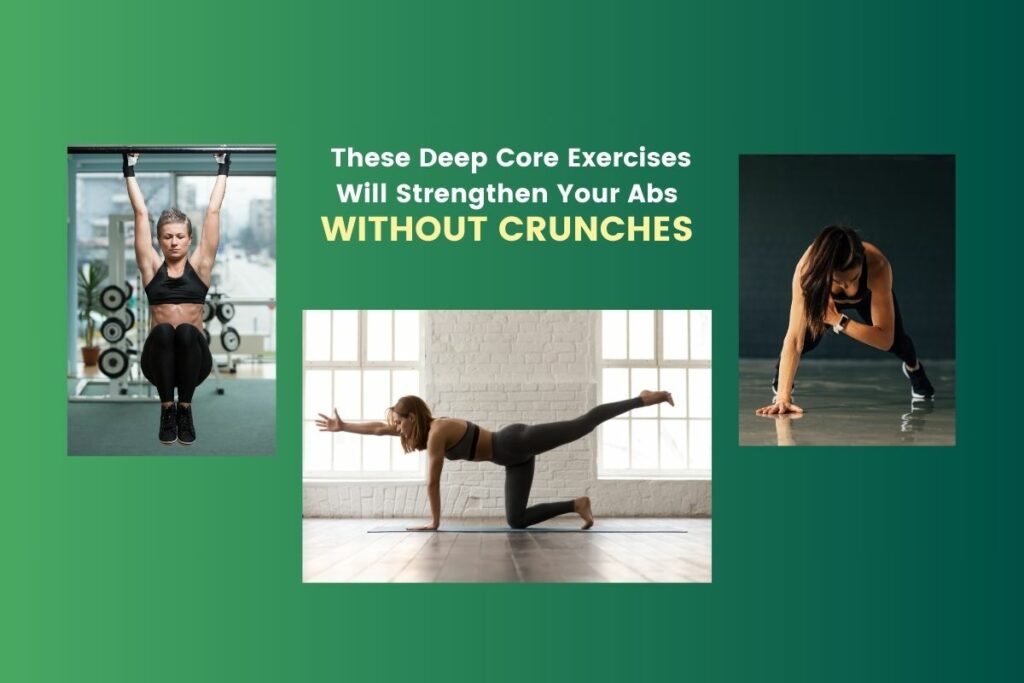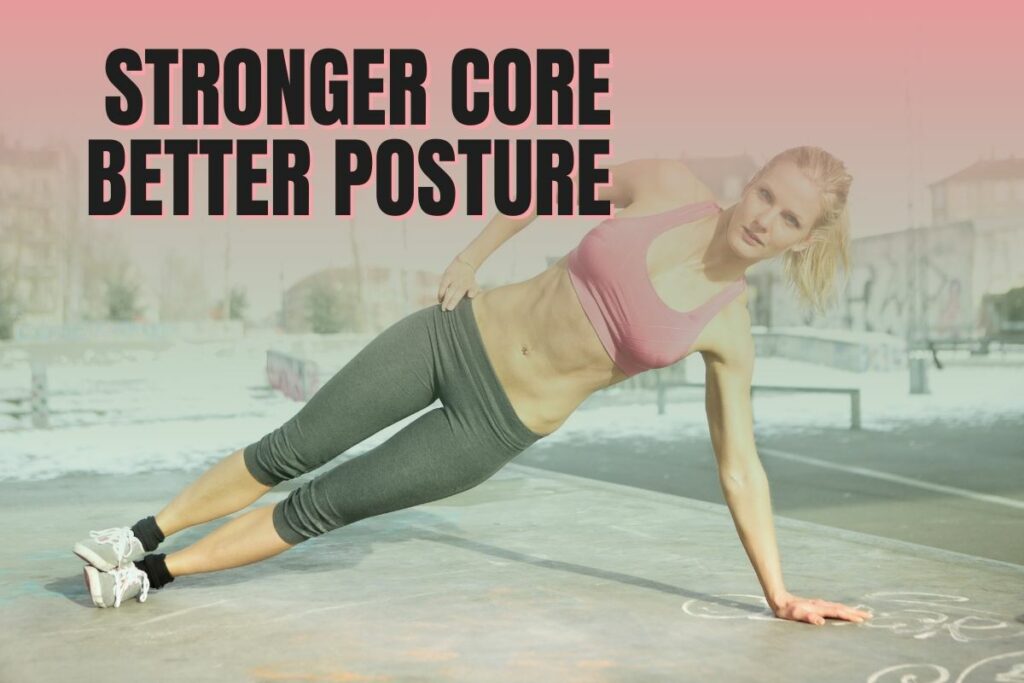Deep Core Exercises That Are Better Than Crunches
Crunches have been the go-to move for core workouts for years, but they aren’t the most effective way to build real core strength.
While they can help strengthen the rectus abdominis—the long, vertical muscle that runs down the front of your abdomen and is responsible for the classic “six-pack” look—they often neglect the deeper muscles that provide stability and support for everyday movements.
Over time, relying too much on crunches can lead to muscle imbalances, poor posture, and even back or neck strain.
If you’re looking for exercises that actually engage your deep core muscles, improve posture, and reduce back pain, you’ll want to switch things up.
The key to a strong core is training the muscles that support your spine, enhance mobility, and improve overall function.
Instead of focusing on repetitive crunches, these deep core exercises target the deeper muscles helping you move and perform better in both workouts and daily activities.

This post may contain affiliate links, which helps keep this content free. Please read our disclosure for more info.
What Are Deep Core Muscles?
Deep core muscles are the foundation of core strength and stability. Unlike surface-level muscles that drive movement, these deeper muscles provide structural support, protect the spine, and help maintain balance.
Here’s a closer look at the key deep core muscles and why they matter:
- Transverse Abdominis (TVA) – Often referred to as the body’s natural corset, the transverse abdominis is the deepest layer of abdominal muscles. It wraps around the torso like a belt, stabilizing the spine and pelvis during movement. A strong TVA helps prevent lower back pain, supports better posture, and enhances overall core strength.
- Multifidus – These small but powerful muscles run along the spine, providing essential support for vertebral alignment and posture. They play a major role in spinal stability, helping to prevent injuries and improve movement efficiency. Weak multifidus muscles are often linked to lower back pain and instability.
- Pelvic Floor Muscles – These muscles form a hammock-like structure at the base of the pelvis, supporting the bladder, intestines, and, in women, the uterus. They work in coordination with the core and diaphragm to control pressure within the abdomen. Strengthening the pelvic floor is important for core function, bladder control, and preventing issues such as incontinence or pelvic instability.
- Diaphragm – Most people think of the diaphragm as only a breathing muscle, but it also plays a crucial role in core stability. It works alongside the transverse abdominis, pelvic floor, and multifidus to regulate intra-abdominal pressure, which is essential for spinal support. Proper diaphragmatic breathing helps engage the deep core muscles and improves core function.
Together, these muscles create a stable and strong foundation for movement. When they are properly activated and strengthened, they improve balance, posture, and coordination, reducing the risk of injuries and enhancing overall physical performance.
Whether you’re lifting weights, running, or simply standing for long periods, a well-developed deep core helps your body move efficiently and stay protected from strain.
Why Crunches Fall Short
Crunches primarily work the rectus abdominis, the topmost abdominal muscle that stretches vertically along the front of your midsection and creates the defined “six-pack” appearance.
While crunches may create a temporary burning sensation in your abs, they don’t effectively strengthen the deeper muscles that provide true core stability. This makes them less useful for improving posture, balance, and overall strength.
One of the biggest drawbacks of crunches is that they involve repetitive spinal flexion, which can place unnecessary strain on the neck and lower back.
Over time, this can lead to discomfort, poor posture, and even an increased risk of injury—especially if they are performed with improper form or in excessive repetitions.
Many people also unintentionally pull on their neck while doing crunches, which can cause tension and discomfort rather than benefiting the core.
Another limitation is that crunches don’t train the core’s primary function: stability. Your core is designed to resist movement, not just create it.
In real-life movements—whether you’re lifting groceries, running, or playing sports—the core is responsible for stabilizing the spine and transferring force between the upper and lower body.
Exercises that challenge core stability, rather than just flexing the spine, are much more effective at building strength that translates into daily life.
Best Deep Core Exercises

The following exercises go beyond crunches by activating the transverse abdominis, multifidus, pelvic floor, and diaphragm—the muscles responsible for core stability and spinal support.
1. Dead Bug
This move strengthens the core while keeping your spine in a neutral position, making it an effective way to engage the transverse abdominis, multifidus, and diaphragm without excessive spinal flexion.
How to do it:
- Lie on your back with your arms extended toward the ceiling and knees bent at 90 degrees.
- Slowly lower your right arm and left leg toward the floor while keeping your core engaged and lower back pressed into the ground.
- Return to the starting position and switch sides.
- Perform 10–12 reps per side, focusing on controlled movement.
2. Bird Dog
This exercise improves core stability, balance, and spinal support by activating the multifidus, transverse abdominis, and pelvic floor muscles while also engaging the glutes.
How to do it:
- Start on your hands and knees in a tabletop position.
- Extend your right arm and left leg at the same time while keeping your hips level and core engaged.
- Hold for a moment, then return to the starting position and switch sides.
- Perform 10–12 reps per side, maintaining control to avoid excessive sway in the lower back.
3. Hollow Body Hold
This is a powerful move for core endurance that strengthens the transverse abdominis, diaphragm, and pelvic floor while teaching full-body tension and control.
How to do it:
- Lie on your back with your arms extended overhead and legs straight.
- Engage your core and lift your arms, shoulders, and legs off the ground while keeping your lower back pressed into the floor.
- Hold for 20–30 seconds, focusing on maintaining core engagement without arching your back.
- Rest and repeat for 2–3 rounds.
4. Pallof Press
This anti-rotation exercise strengthens the transverse abdominis and multifidus by training the core to resist movement, which is essential for spinal stability.
How to do it:
- Attach a resistance band to a sturdy anchor at chest height.
- Stand sideways to the anchor, holding the band with both hands at the center of your chest.
- Press the band straight out in front of you, resisting the pull from the side.
- Hold for a second, then return to the starting position.
- Perform 10–12 reps per side, ensuring your torso stays steady.
5. Plank Variations
Planks train core endurance better than crunches by engaging the transverse abdominis, multifidus, and diaphragm while reinforcing full-body stability. Try these variations:
- Side Plank – Strengthens the obliques and enhances lateral core stability.
- Hip Tap Plank – A dynamic core exercise that enhances stability, anti-rotation strength, and oblique engagement.
- Plank with Shoulder Taps – Adds an anti-rotation challenge, forcing the deep core muscles to stabilize against movement.
How to do them:
- Hold a plank position for 30–60 seconds in any variation, ensuring your body remains in a straight line.
- For hip taps, drop the hit to the side and tap the floor lightly (or hover just above it), then return to the center.
- For shoulder taps, lift one hand at a time to tap the opposite shoulder while minimizing hip movement.
6. Hanging Leg Raises (or Reverse Crunches)
These exercises target the transverse abdominis and lower rectus abdominis while avoiding excessive spinal flexion.
How to do them:
- Hanging Leg Raises: Hang from a bar and lift your legs toward your chest with control. Avoid swinging.
- Reverse Crunches: Lie on your back, engage your core, and curl your hips toward your ribcage without using momentum.
- Perform 10–12 reps per set, ensuring proper form and controlled movement.
7. Breathing and Core Engagement Drills
Proper breathing is key to core function and stability, ensuring the diaphragm and pelvic floor muscles work efficiently with the rest of the core.
Try these drills:
- Diaphragmatic breathing – Breathe deeply into your belly rather than your chest, allowing the diaphragm to fully expand. This enhances core engagement and reduces tension in the upper body.
- Bracing drills – Engage your core as if preparing to take a light punch to the stomach, creating a stable base for movement and lifting.
How to Incorporate These Exercises into Your Routine

To get the most out of deep core training, it’s important to strategically integrate these exercises into your workouts.
Since these movements focus on stability and control, they can be used in a variety of ways—either as a standalone core workout, as part of a warm-up, or incorporated into strength training sessions.
Here’s how to make them a regular part of your routine:
1. Select 3–4 Exercises Per Session
Instead of doing every exercise in one workout, choose a few that complement your current training plan. For example:
- If you’re focusing on strength training, pair Pallof Press or Planks with compound lifts like squats or deadlifts.
- If you want to improve core endurance, add Hollow Body Holds or Bird Dogs to the beginning or end of your workout.
- If you’re looking to build anti-rotation strength, Hip Tap Planks and Pallof Press are great choices.
2. Perform 2–3 Sets with Focus on Control
Unlike crunches or fast-paced ab exercises, deep core training is about quality over quantity. Perform 2–3 sets of each chosen exercise, ensuring that you:
- Move slowly and deliberately, engaging the core throughout.
- Avoid using momentum or letting other muscle groups compensate.
- Maintain proper form, especially when performing stability-based movements like Planks or Dead Bugs.
3. Pair Them with Full-Body Movements
The core doesn’t function in isolation—it works to stabilize the body during complex movements. Incorporating deep core exercises into a full-body routine can enhance strength and performance. Try:
- Squats & Deadlifts – Engages the deep core muscles to keep the spine stable under load.
- Lunges & Single-Leg Exercises – Challenges core balance and stability.
- Push-Ups & Rows – Requires core engagement to prevent excessive movement in the spine.
Adding a Pallof Press before heavy lifts or doing Plank Variations after lower body exercises can reinforce core activation when you need it most.
4. Train the Core 3–4 Times a Week
You don’t need to train your core every day for results. 3–4 sessions per week is enough to see improvement, especially if you’re engaging these muscles during other exercises. Rotate exercises throughout the week to prevent overuse and ensure well-rounded strength.
5. Prioritize Quality Over Reps
Deep core exercises are most effective when performed with proper form and muscle activation. Rushing through reps reduces their effectiveness and can lead to compensations in other areas. Instead:
- Slow down your movements to feel the muscles working.
- Breathe properly to engage the diaphragm and maintain core stability.
- Modify as needed—if you lose form, adjust the difficulty rather than pushing through poor execution.
6. Use Them as a Warm-Up or Finisher
- As a warm-up, core activation drills like Diaphragmatic Breathing, Bracing Drills, or Bird Dogs can prime your body for heavy lifts and prevent injury.
- As a finisher, moves like Hollow Body Holds or Hanging Leg Raises can fatigue the core at the end of your session for added strength development.
7. Progress Over Time
Once these exercises become easier, you can increase difficulty by:
- Adding resistance (bands, weights) to Pallof Press, Planks, or Bird Dogs.
- Extending hold times for Hollow Body Holds or Planks.
- Increasing reps for Dead Bugs, Hip Tap Planks, or Hanging Leg Raises.
- Combining movements, like adding a Shoulder Tap to Planks for extra control.
By consistently incorporating deep core training into your workouts, you’ll build a stronger, more resilient core that supports your entire body, improves posture, and enhances athletic performance.
Build a Stronger, More Stable Core with the Right Exercises
If you want a core that is not only strong but also supports your body in real-life movements, it’s time to move beyond crunches.
Prioritizing deep core exercises will help you develop better stability, improve posture, and reduce the risk of injury.
These movements target the muscles that truly matter for strength and function, giving you a solid foundation for everything from lifting weights to maintaining better balance and mobility.
By incorporating these exercises into your routine, you’ll notice improvements in how you move, feel, and perform—both in workouts and daily life.
Start making the shift today and experience the benefits of a stronger, more resilient core!
